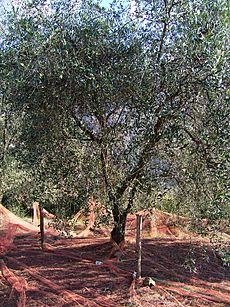Cailletier facts for kids
Quick facts for kids Cailletier |
|
|---|---|

Cailletier used in a salad
|
|
| Olive (Olea europaea) | |
| Color of the ripe fruit | Black |
| Also called | Niçoise |
| Origin | France, Italy |
| Notable regions | Alpes-Maritimes, Italian Riviera |
| Hazards | Olive fruit fly, Saissetia oleae, cold |
| Use | Oil and table |
| Oil content | High |
| Fertility | Self-fertile |
| Growth form | Erect |
| Leaf | Elliptic-lanceolate |
| Weight | Low |
| Shape | Ovoid |
| Symmetry | Symmetrical |
The Cailletier is a special type of olive tree. It is also known by its Italian name, Taggiasca. This olive grows mostly in the Alpes-Maritimes area near Nice, France. You can also find it along the Italian Riviera in Italy.
The Cailletier olive is famous for its curing method, which gives it the name Niçoise. These olives are a key ingredient in the delicious salade niçoise. They are also used to make olive oil. However, this olive tree can be easily affected by the olive fruit fly.
Contents
Where Do Cailletier Olives Grow?
The Cailletier olive is very common in the Alpes-Maritimes region of southern France. It is the main type of olive grown there. You can also find it in nearby Liguria in Italy. This olive tree has even spread to places like Japan, Australia, and the United States.
What Are Other Names for Cailletier Olives?
In Italy, this olive is called Taggiasca. This name comes from the town of Taggia. In different local areas, it has other names too. Some of these names include Cayet, Cayon, Grassenc, Olivier de Grasse, Pendoulier, and Pleureur. The name Niçoise is not another name for the olive itself. Instead, it describes how the olive is prepared and cured.
What Do Cailletier Olives Look Like?
The Cailletier olive tree is strong and grows quite large. It has an upright shape. Its leaves are medium-sized and shaped like a long oval. The olives themselves are small and have an oval shape. They are also symmetrical, meaning they look the same on both sides.
The pit inside the olive has a rounded top and bottom. It has a rough surface and a small point.
For making olive oil, these olives are picked in mid-November. If they are going to be eaten as table olives, they can be harvested later, even until May. When the olives are fully ripe, they turn a dark color. This color can range from brownish-purple to brownish-black.
How Are Cailletier Olives Used?

The Cailletier olive is a "dual-use" type. This means it can be used for two main things: making olive oil and eating as table olives. Even though the pit is quite large, these olives produce a good amount of oil, usually 20% to 25%.
The oil from Cailletier olives is sweet and delicate. People who are new to olive oil often enjoy its mild taste. It can taste a bit like fresh almonds and hazelnuts. If you prefer a stronger, more bitter oil, the olives are picked earlier in the year.
In France, the Cailletier olive is used in three special products. These products have official labels called appellations. They are "AOC Huile d'Olive de Nice" (Nice Olive Oil), "AOC Olive de Nice" (Nice Olives), and "AOC Pâte d'Olive de Nice" (Nice Olive Paste). In Italy, the quality of the Taggiasca olive is protected by special rules called PDO (Protected Designation of Origin).
The most famous way Cailletier olives are used is in Niçoise salads. For this, the olives are cured until they turn black. This curing process happens in the Nice area, which is why they are called Niçoise olives.
Growing Cailletier Olives
Cailletier olive trees are known for producing a lot of olives. However, they tend to have "biennial bearing." This means a year with a big harvest is often followed by a year with a smaller one. Most experts agree that these trees can pollinate themselves. This means they don't always need other olive trees nearby to produce fruit. But some still suggest having other pollinators just in case.
These trees can be affected by certain pests. The main one is the Bactrocera oleae (Olive fruit fly). Other risks include the Saissetia oleae, Spilocaea oleaginea, and Sooty moulds. Starling birds also really like to eat Cailletier olives. While the trees can be a bit sensitive to cold weather, they are very good at resisting drought.

